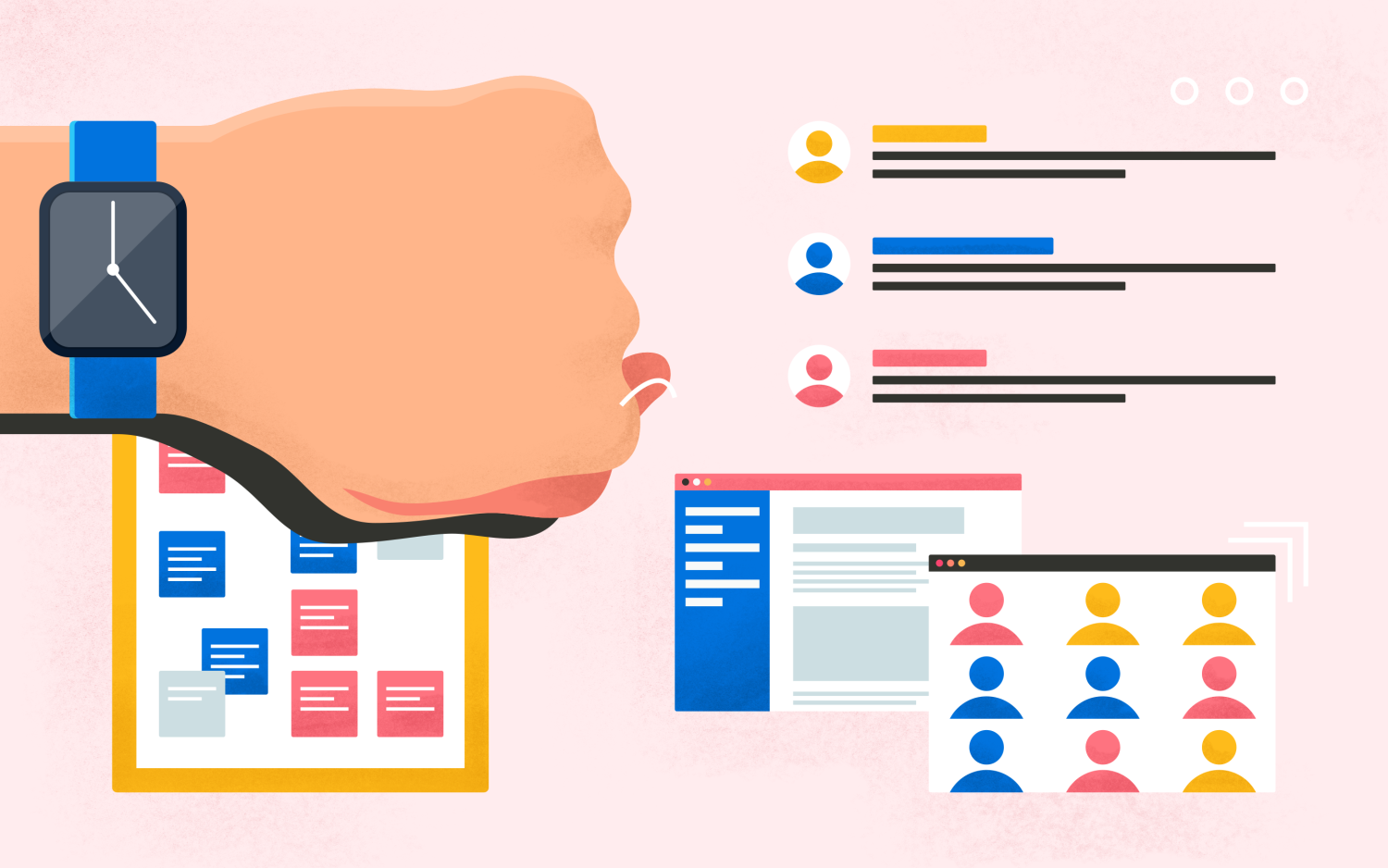Practical tips from one Duo Security designer on using intentional, human-centered collaboration to solve complex problems together.
It’s remarkably easy to go into a project thinking you know what you’re building. The feature seems pretty straightforward, or at least you have an idea of how to approach it. But those initial broad strokes are rarely — okay, never — the whole picture.
When you start digging into a new project, there is so much more than meets the eye. Forgotten dependencies can mean longer term problems and a lot of frustration. Because of this, collaboration is a key skill any good designer must embrace and try to master.
Being more communicative, sensitive and empathetic — not just to our users, but to our coworkers — fosters goodwill and creates better outcomes for everyone. Relationships are at the core of design, so the teams and people we work with every day (whether virtually or in person) shouldn’t be an exception.
That said, while great collaboration is key, it’s not always easy. On that note, here are a few of the thorniest issues I’ve run into when trying to get the collaboration ball rolling and how I’ve approached them.
Identifying stakeholders
Keeping track of who’s on what team (within design and outside of it) is easier said than done. We’re always growing and shifting. People change focuses and jump onto new projects every day. You no longer work with every designer on a day-to-day basis, if at all.
The start of a project can feel like an investigation, and you don’t want to miss any of the key pieces. There may be a track of work that you weren't aware of in a different project that you had no idea existed. Conversations and decisions can happen at the speed of light. Dependencies can be a doozy.
So who do you invite to the kickoff meeting?
Try this:
Add your current project, team and role to your bio, whether that’s on a directory, messaging platform, or somewhere else — and encourage others to do the same.
Make sure that important links and team resourcing are kept up to date and are easily accessible. Well organized project pages, documents or Wikis can be great tools. Pinning important links in highly visible communication channels can also help.
Sketch out connections. Which teams, functionalities and other projects impact your work? What downstream effects could your work have on others? A little due diligence at the start of a project can go a long way and can point toward who to talk to.
Once you have an idea of which teams may be involved, ping a lead and ask them who from their group should be involved in the discussion. Avoid “too many cooks in the kitchen” by inviting representatives, not entire groups, for different functions across teams. This can help provide focus without sacrificing impact or inclusivity.
Scheduling around everyone
The dreaded act of ‘calendaring.’ Struggling to find that one 30-minute slot everyone has available at some point during the quarter is daunting.
Trying to match up schedules and find a date that isn’t three weeks into the future can seem impossible, especially when you’re trying to get all the stakeholders together. Inclusivity is great, but everyone is so busy. It was easier when our teams were small and/or co-located, but they’re now neither of those things.
Try this:
Just book something, even if you don’t have an agenda yet. You can always cancel it later, but getting time with key stakeholders means getting started early. You may be booking two to four weeks in advance.
Set up recurring time when possible with key stakeholders at the outset of a project.
Identify who’s optional and who must attend for the meeting to be a success.
Record and/or summarize meetings for those who can’t attend. Share the decisions made.
Contact people who are unavailable to see if they can reschedule a meeting that conflicts with yours. It may just take that one meeting to unblock and enable a much earlier sync.
Keep calendars up to date, and communicate which meetings cannot be rearranged.
Reaching consensus
You have a handle on the problem, and a few ideas for solutions, but who makes the final call? It’s easy to discuss things to death, especially when half the chatter is happening over Slack.
Nothing like coming back from lunch to, “You’ve been mentioned in a thread. Show 103 more messages.” Oof.
Next time, try this:
Utilize asynchronous feedback. Capture feedback inline on documents or prototypes. Perfect for time zones, schedules, tough calendars.
Encourage the team to get off Slack threads. Suggest an audio call or huddle for something leaner, or a video meeting for a more involved discussion.
Include an agenda in your invite well in advance, and questions to answer, for more efficient and productive meetings. Consider sending a reminder the day before to review the agenda.
Make sure your key stakeholders are present or get to review decisions before they’re finalized. Missing someone on an invite is easy, but the impact means people feel unheard and singled out.
Put it out there, even if it’s messy or not “correct.” Create a doc or a design. Create a rough sketch — even if it’s just on paper (!). Share it. Get feedback. It’s easier to get feedback on something concrete. This leads to more productive conversations about tangibles vs. imaginaries, allowing you to move one step closer to consensus.
Get everyone in a “room” (virtual or otherwise) and drive toward decisions. Set a tactical agenda with intended outcomes.
Having things written down (not in Slack) really helps. Tag folks for visibility (for example. mention them in a Google Doc).
Aligning roadmaps and goals
Across disciplines and teams, we all have our own roadmaps, quarterly goals and task sizes. Sometimes our goals and release dates can compete, and something that feels urgent to Team A may be on the back burner for Team B.
These key details can exacerbate all of the other aspects that are hard about collaboration!
Consider:
Getting the important people together. Align on important dates, objectives and deliverables across teams at the outset. Discuss timeline, quarterly goals, etc. up front to get a big picture overview.
Creating a shared workstream calendar. Who is working on what, major milestones, percentage of time dedicated to a project (many people are on more than one!), and any other relevant information across teams.
Communication lapses into roadblocks
Communication is key to good collaboration, but sometimes it fails or falls flat. This can leave you or others feeling put out, ignored or simply blocked.
On the other hand, you may also unintentionally find yourself in the role of “blocker.” It’s not a great feeling when you reach this realization, especially if it ends up creating more work for another team or contributor.
Try this:
Take the conversation out of your messaging tool. Set a 30-minute meeting when you and a key collaborator both have time available. Sometimes carving out a little space for a real conversation can go a long way. I recently resolved a week-long miscommunication with a coworker simply by talking it out on a quick, informal call to clarify expectations.
Document and socialize decisions and commitments. What did we decide on? Who is responsible for executing which part? When does it need to be delivered? Sometimes a perceived lack of urgency or follow through may really stem from a failure to set expectations.
Help avoid being a “blocker” by being honest about your bandwidth for collaboration. We’re all busy, and sometimes it’s okay (or even better) to say “no.”
Try pairing your “no, sorry” with a suggestion or other resource to reach out to. Expectation setting is an important part of collaboration and better communication.
If you’ve been holding someone up, or if your miscommunication has created an issue, it’s natural to feel responsible (or even guilty, if you’re like me). If the situation calls for it, an apology may be warranted, but try not to dwell: pivot into action instead. Consider: “What steps can I take to unblock and resolve the situation right now?”
For either scenario, retrospective sessions to discuss what went well and what didn’t during a project can be a helpful way to iterate and improve on future processes.
Always assume positive intent
I think this suggestion for effective communication is too important to be summarized as a bullet point. It’s easy to fall into a place of frustration and antagonism when you feel blocked by someone. I truly think it’s one of the biggest barriers to effective collaboration.
I’ve been guilty of falling into this pattern when I feel blocked by someone, especially when I have outside stressors. It’s easy to adopt the line of thinking, “Why is this person blocking me? Why are they being so unprofessional?”
But one of our chief values at Duo is simply “kinder than necessary.” That goes hand in hand with assuming positive intent. If you take away nothing else from this post, that simple principle can make a world of difference.
Whatever helps you find your zen.
And then get back to it. Don't focus on what you can’t do, but instead on what you can do right now. Take action.
Remember that we're all humans with distractions, both work-related and distinctly not work-related. It’s something that I think is easy to forget when we're on our little bubbles working remotely, or going heads down.
Many of my coworkers reading this may not know that I’ve lost two friends in the past year, that I’ve been on more than five different medications to try to address chronic fatigue and other health issues, or that I struggle particularly with focus work. Imagine all the things I don’t know about them.
Some of the tips I wrote about might work for you and your team — or maybe there’s a solution or solutions better suited to your team’s needs. But at the core of it all, your efforts towards collaboration will fall flat if you fail to forget that at the end of the day, we’re all human.
Assume positive intent. Assume we’re all doing our best. Be compassionate. Be kind. If we lead with kindness and give our best effort, the rest will fall into place.




